Expressing Hope by Painting Nature
These past weeks have been black. Social distancing, pandemic, the news … However, I want to share some things that have brought consolation, hoping that they do the same for you.

This first image is a watercolor painting created as an exercise for my newest class Magical Forest. It’s painted quickly and systematically, and it’s less romantic than many of my paintings, but I really like it. I put a lot of effort and thought into all of the class exercises, but I am especially fond of the last lesson where realistic nature themes meet abstract art in unconventional ways.
Expressing Hope – Art is Needed!

One of the carrying themes in Magical Forest is spirituality, and I feel that the connection between art and spirit is more timely now than ever. The need for art that soothes will grow. It’s important that we artists create images that illustrate the inner world when there are chaos and uncertainty in the outer world. This way, we don’t only take care of our sanity but spread hope for other people as well.
Moss, Stones, Clouds – The Comforting Side of Nature
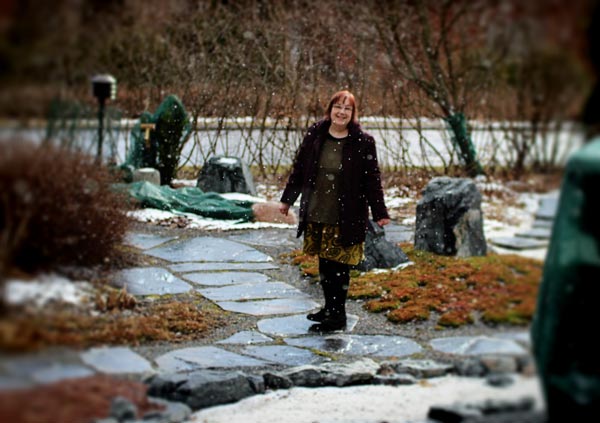
We haven’t got much snow this winter in Southern Finland, so I have had lots of opportunities to observe stones, both in our garden, and in nature. When the world is in a storm, it’s comforting to watch their stillness, and how the moss is like a warm blanket over them.

Last weekend, my husband and I took the dogs for a walk in the forest. When the sun shined through the trees, the view was like a sacred chapel.
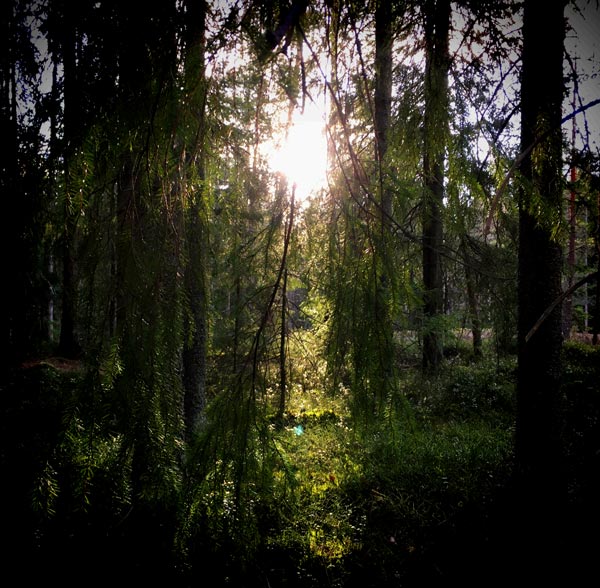
Last year, I got a wish to include clouds in the class, and I was able to fit that in. Clouds are surprisingly fun to paint! When the bad news came, little paintings like this became even more important. I want to look at my clouds now and then. The softness of the sky draws in and refreshes my soul.

My beagle Stella also likes sunny skies. She has her chapel on the porch of the old shed that we have in our back garden.
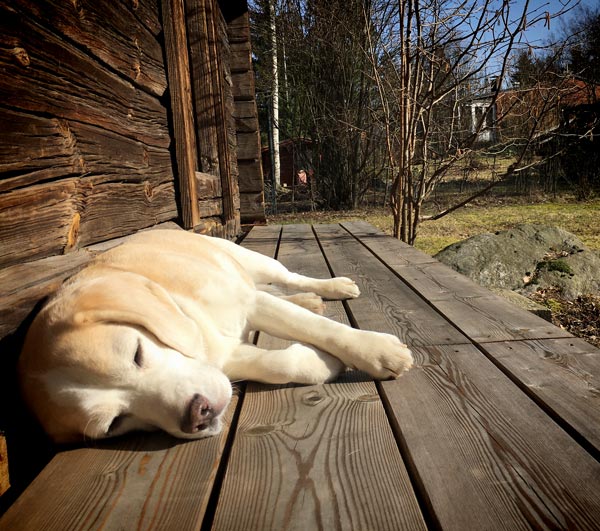
I painted this floral bouquet last spring, and with it, I want to wish hopeful news and hopeful weekend. Let’s take some time to create comforting art!
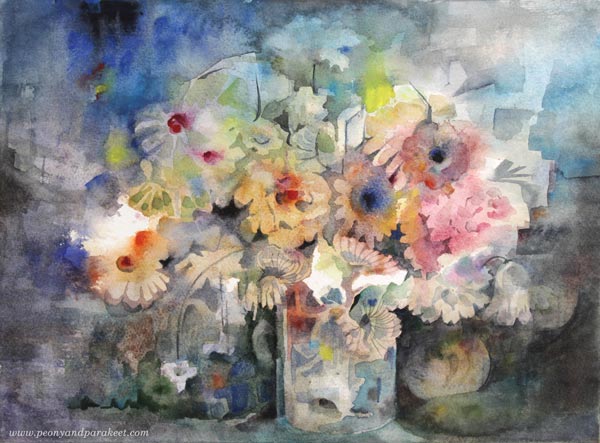
Nature is definitely expressing hope here in Finland. Let’s keep creating towards brighter days!

P.S. Weekend Sale! There’s a new presentation video about Magical Forest, and to brighten the weekend, I have reduced the price too. The sale ends on April 5 (PDT), so be quick! >> Buy here!
Art Inspiration from Sanditon
This blog post is for us who love Jane Austen and Sanditon tv series. I watched the series last month, and it has inspired me a lot. I hope you enjoy this Sanditon inspiration overload!
Torchbearer – Esther and Lord Babington on the Beach
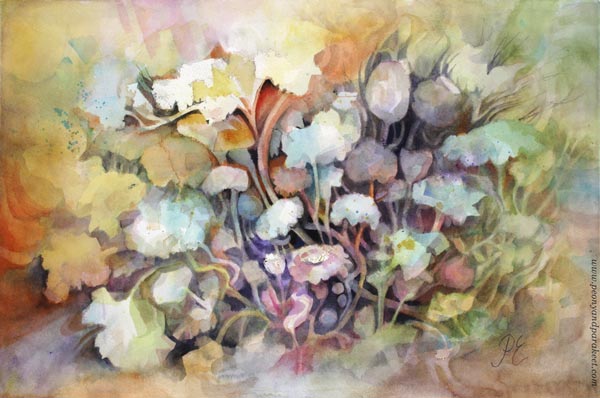
My newest watercolor painting called Torchbearer had a modest beginning and I had no clue how to finish it – until I saw episode 8 of Sanditon!
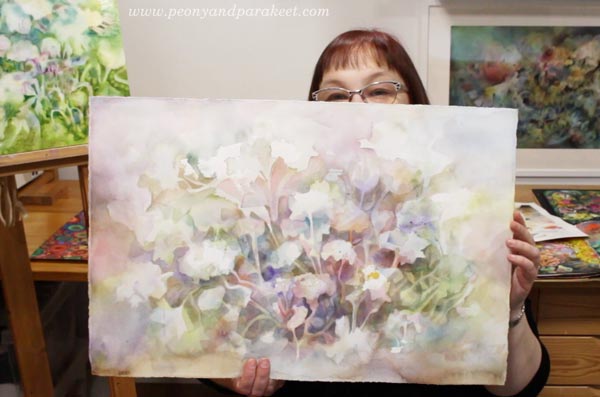
My favorite female character of Sanditon is Esther and the scene where she is in the carriage with Lord Babington was so romantic! The sudden change in her appearance, his gentle smile, black horses, empty shore – oh my! It hit me, that even if my painting has flowers, not people, I could express the emotion from the scene.
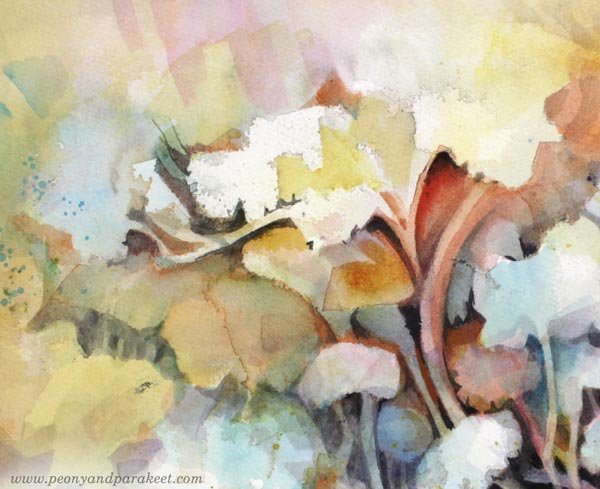
The tallest flower and the glow come from Esther’s powerful spirit.
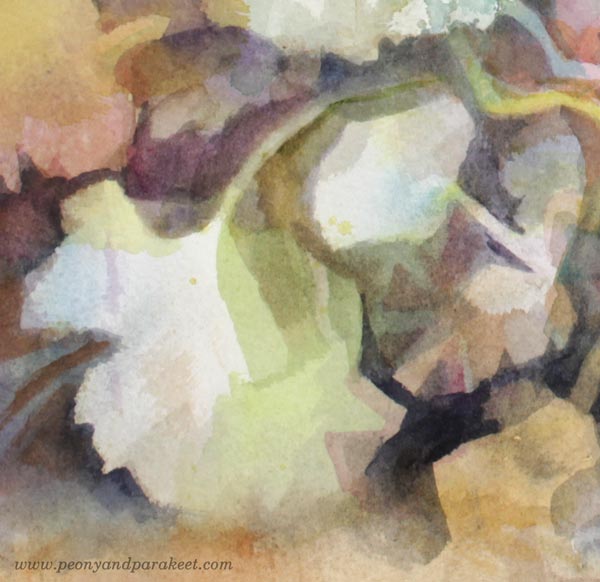
The flower that bends down, expresses her sensitivity.
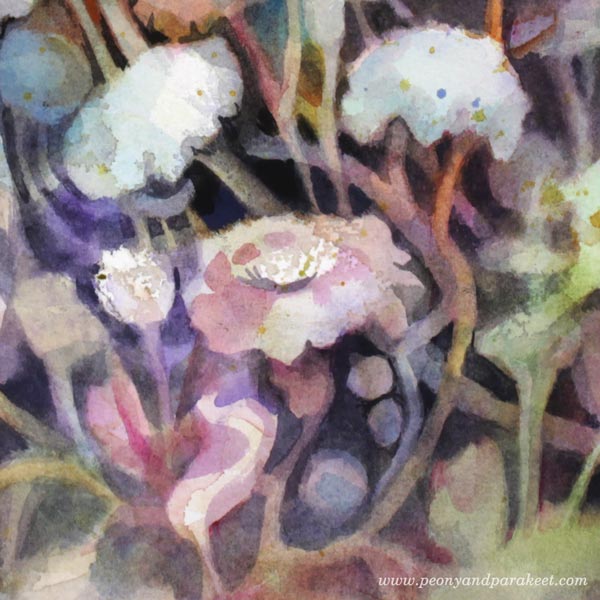
I tried to paint every flower so that they highlight the bubbling energy. Their stems are like the carriage where the couple sat.
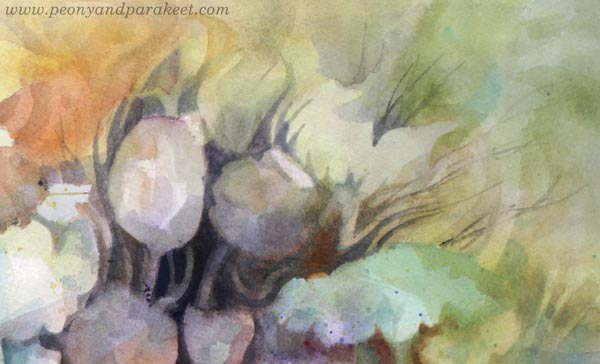
The black background represents both the horses and the lord, supporting Esther’s joy.

In this painting, Esther is a torchbearer who leads us to better times.
Tin Box – A Souvenir from Sanditon
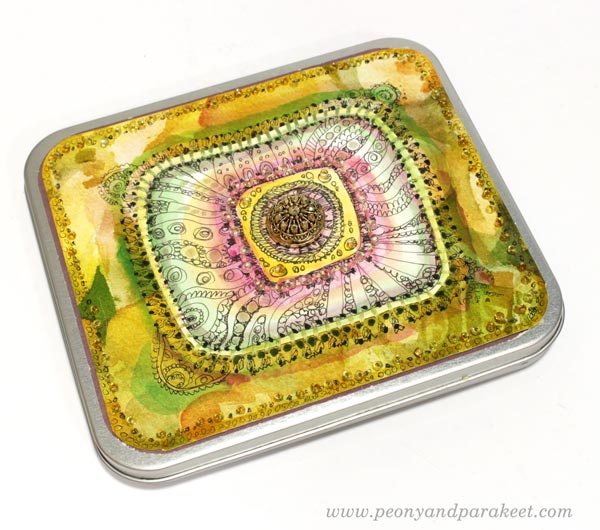
I like little boxes that can be used for storing hand-drawn pictures and papers. I wanted to decorate a small tin box so that it would have old-fashioned and luxurious feel. So that I could think of it as a souvenir from Sanditon!
I already had saved a hand-drawn piece that was quite perfect in size.
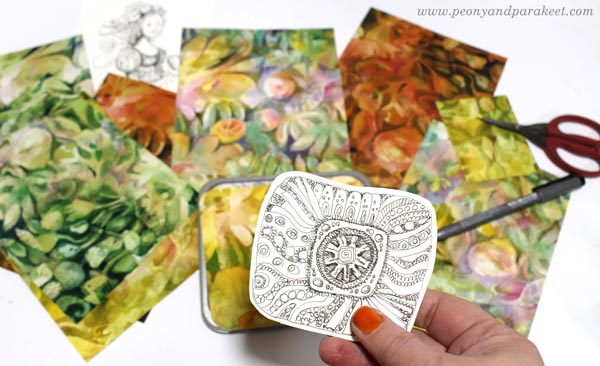
I also found some papers with a watercolor print. They were test runs of the surface pattern designed earlier this year. I mostly designed the pattern manually, so by painting a design on the center of the paper and then cutting the paper into four parts.
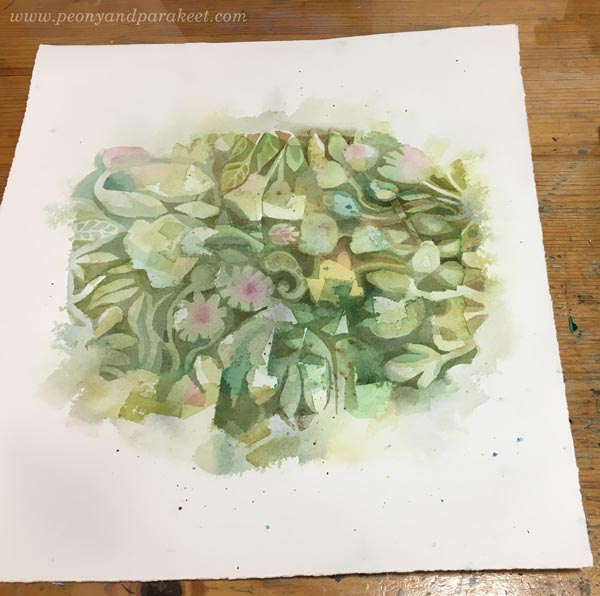
This way you get a continuous design.

Avoid painting edges, and re-arrange papers until they are all fully painted.
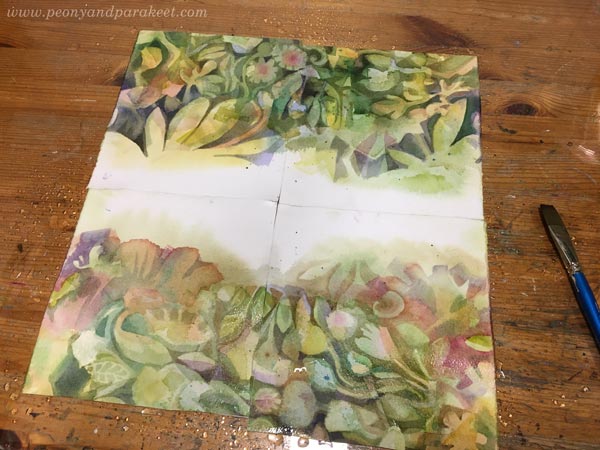
Then scan the papers, and clean the edges in an image processing software. Here’s a sample of my design.
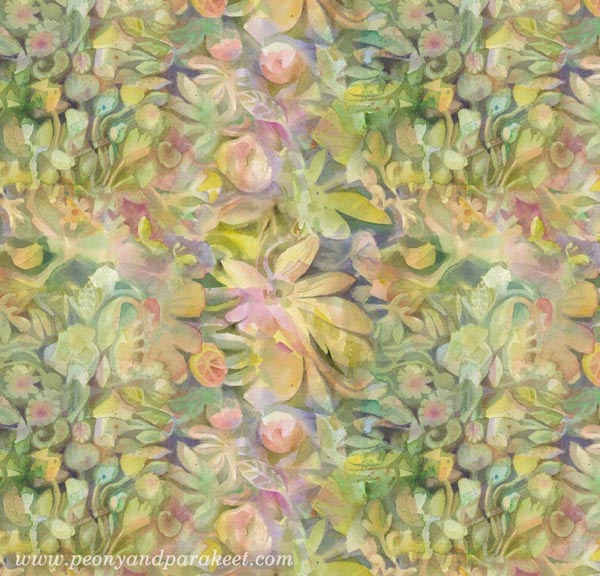
I made several variations in Photoshop. These papers go really well with hand-drawings, so they were perfect for the box.

The center motif was first colored with watercolors.
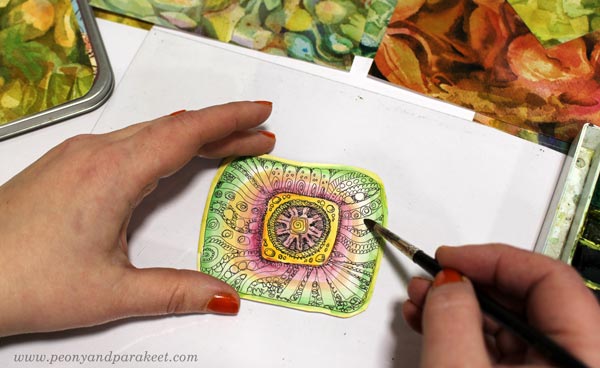
Then I hand-stitched it on a background paper and added more hand-stitching around the center. In the photo below, I highlight the surroundings of the stitches with a pen so that they look more 3-dimensional.
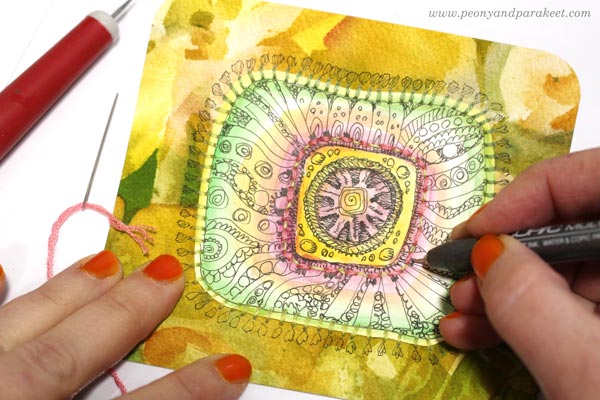
I also added beads, more colors and decorative marks.
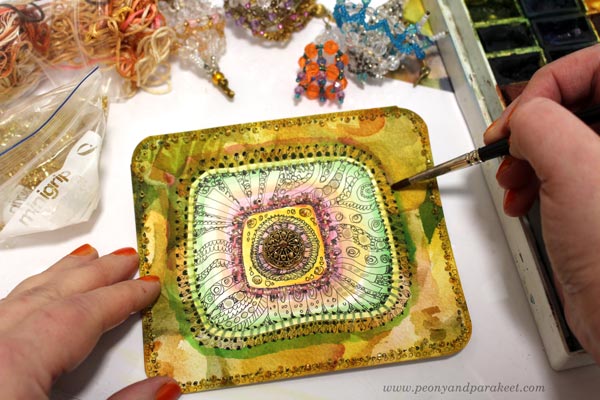
The centerpiece is a button with a shank removed. I love this little box!

Esther Denham – Sanditon Paper Doll
I also wanted to create something for my ever-growing collection of collage figures. “Just an unknown habitat of Sanditon”, I decided first. I didn’t use any reference and drew the doll just freely, but when she was colored, she looked just like Esther!
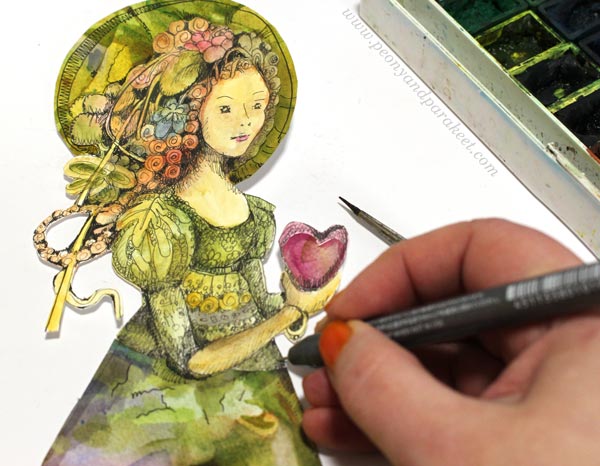
I played with her proportions so that she has overly long legs. That way I could make the dress more imaginative. The hem was cut from one of the watercolor papers. I couldn’t help playing with her right away, trying wings on her, filling the teacup with herbs from Sanditon. The wings and the teacup are from my fun class Magical Inkdom.
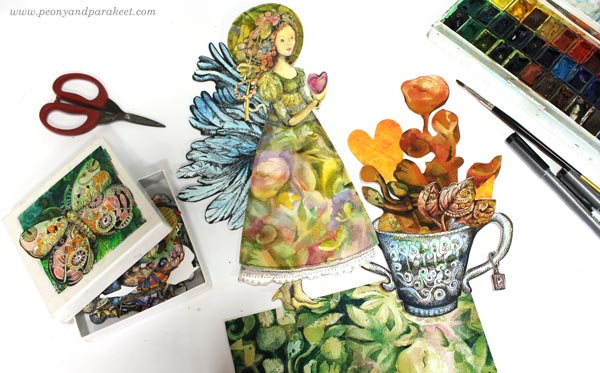
Her hat is also a collage piece cut from watercolor papers.
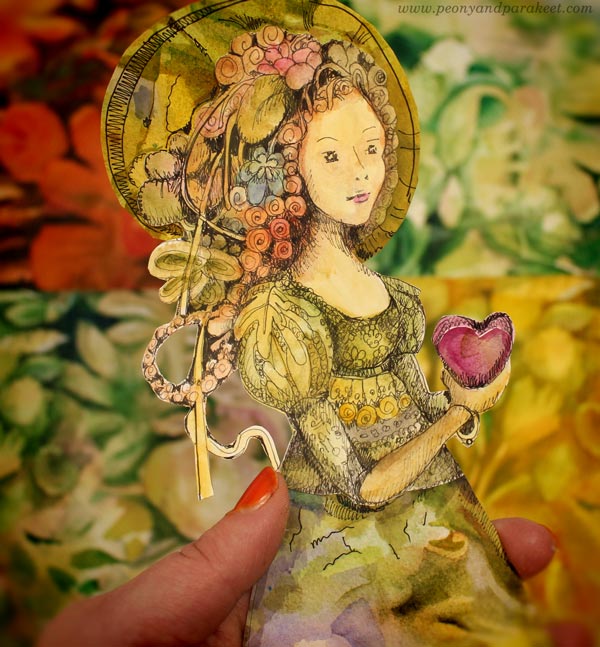
Souvenirs from Sanditon!
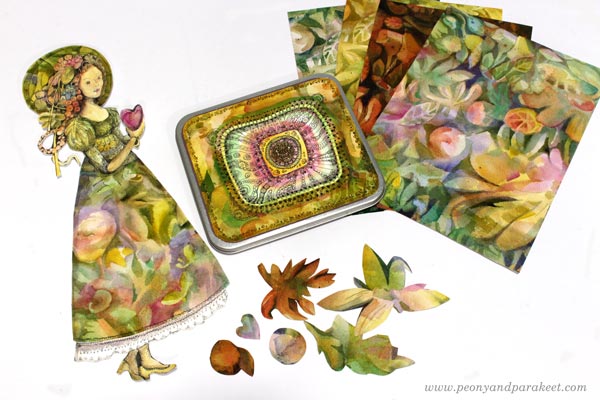
The Romance Continues
I am currently painting an oil painting that looks quite romantic already.
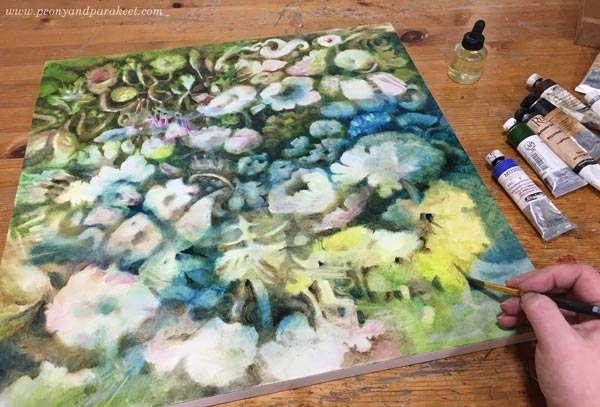
My vision is to make it the third in the series after Icebreaker and Torchbearer – and put it in the middle of them.
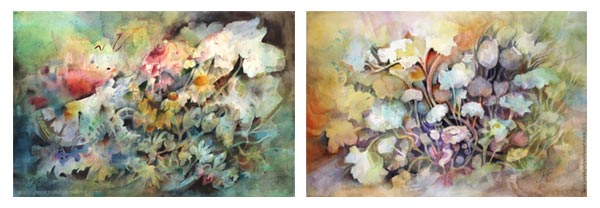
One Source of Inspiration – Many Interpretations
If you have been following my blog, you know that some of my projects are fine art, others more illustrational, and there can be a bit crafty things too. This blog post demonstrates well how the inspiration can be the same, but the interpretation is different. For me, the wide range of projects is a way to stay inspired and creative, and I hope that you have tolerance for all of them. I don’t believe in getting too serious or not getting serious at all. The humorous side of art allows us to get playful, and the playfulness feeds our ability to express the deeper side of our inspiration.
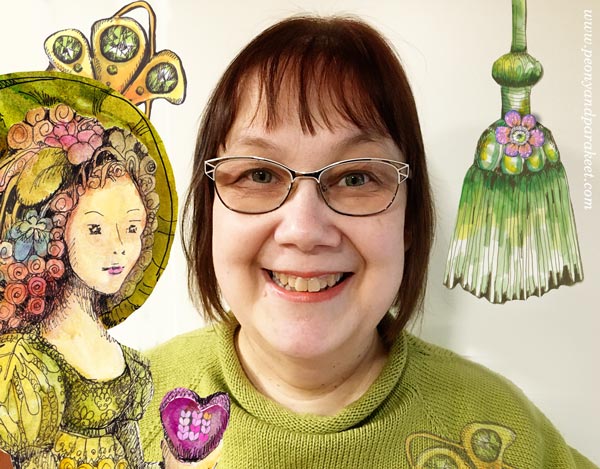
Esther can be the person who handed me a crafty gift box, or an innocent paper doll, or a mysterious flower in a painting that took tens of hours to create. The key to your artistic style is less in the looks and more in the inspiration. For me, it’s often old-fashioned romances, like Sanditon.
Welcome to my online classes!
– Paint watercolor fantasies – Sign up for Magical Forest!
– Draw the magic – Buy Magical Inkdom!
Painted Paper Collage – 6 Tips for Intricate and Fun Art
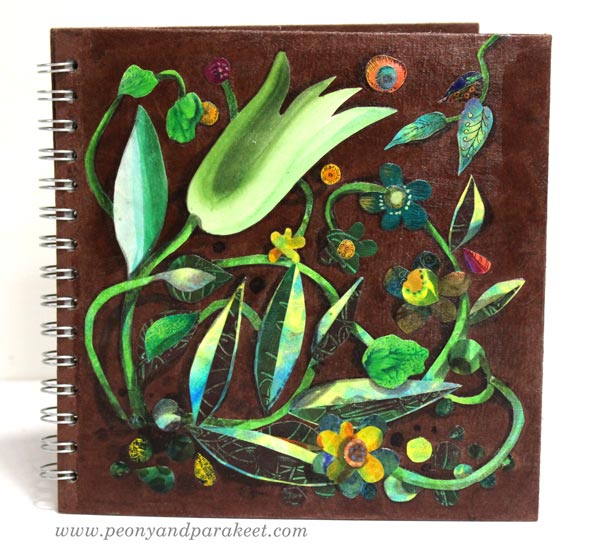
Here’s an 8-by-8-inch sketchbook that I decorated with painted paper collage. Even if all my art is not collage art, I love it. Painted collage art often replaces traditional sketching so that I paint and cut papers to grow the ideas that don’t feel mature enough for bigger work.
In this blog post, I share some tips that are handy for this kind of creative play.
Tip #1 – Organize Painted Papers by Size
I have a box for small paper pieces and another for bigger ones. I keep the papers rectangular in shape so that they are easy to browse.

Tip #2 – Add a Lined Adhesive to the Tiniest Pieces
I like to make intricate collage art so I have tiny collage pieces. Small hand-cut pieces are difficult to handle and get lost easily. Thermoweb has clear adhesive dots called Zots (affiliate), that come with two liners, and they are perfect for both storing and attaching small paper pieces.
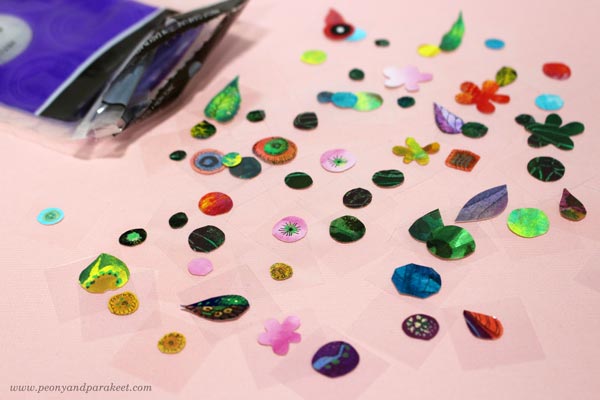
Zots are very flat compared to many glue dots, and they have two liners. Just remove the first one, attach the piece, and then remove the second liner when gluing the piece on a collage! Here you can see a close-up picture. This is the smallest size of Zots.
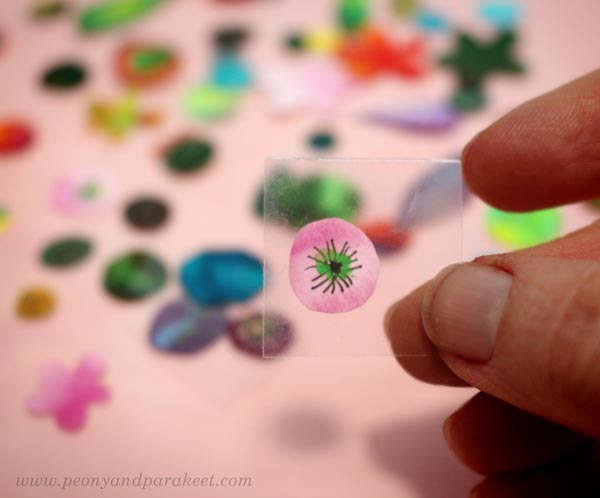
Tip #3 – Make Clusters
Attach small pieces on the bigger elements and treat each piece as a small artwork!
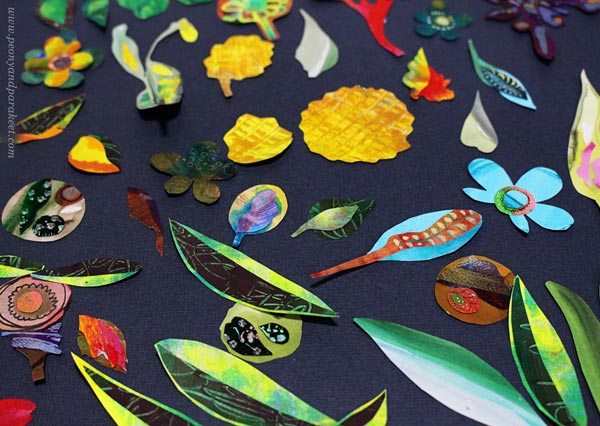
I also like to decorate clusters by painting and drawing.

However, I sometimes have elements that are so beautiful that they don’t need anything on them.
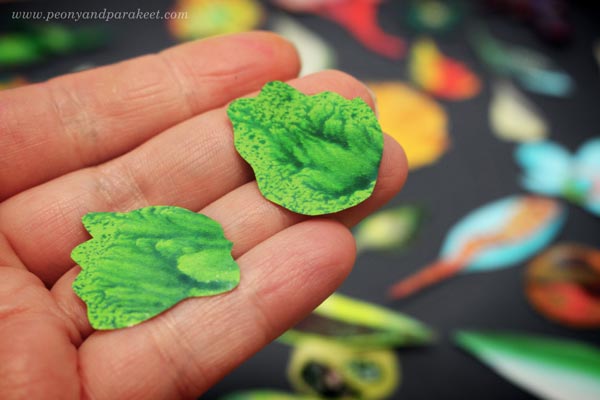
Tip #4 – Group and Layer!
When composing the painted paper collage, use connecting lines and intersecting shapes. They make a more elegant and coherent composition than if the elements don’t touch each other.
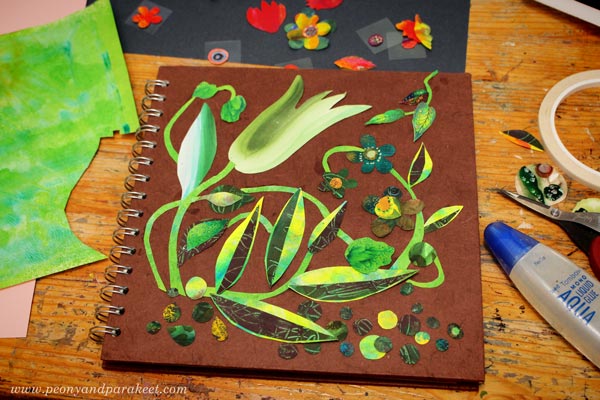
Tip #5 – Add Shadows
For the sketchbook cover, I used grey Faber-Castell PITT Artist Brush Pens (affiliate) to color shadows on both the elements and the background.
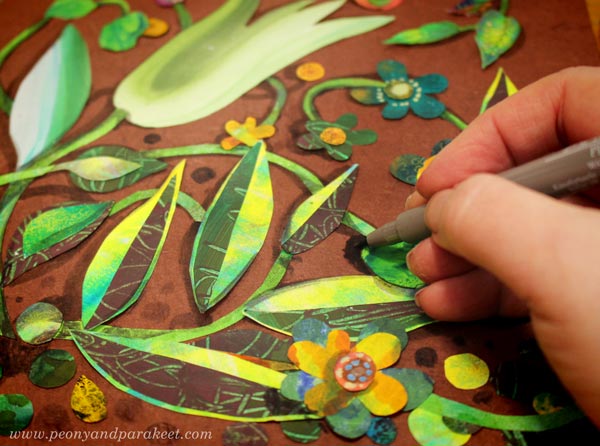
Shadows add depth and make the elements look less separate from the background.
Tip #6 – Sealing
I like to attach the collage elements first with glue dots, double-sided tape, or some paper glue and then use gel medium for sealing. This way, my fingers stay fairly clean when I am building the composition. At that stage, I attach the elements only partly, and they get glued when I am sealing the work.
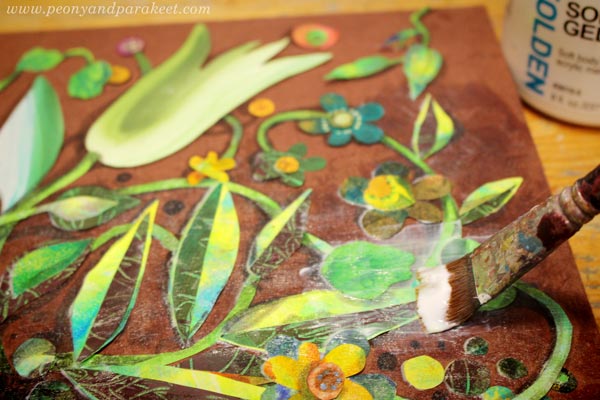
For sealing, I use several layers of gel medium (Golden Soft Gel Gloss (affiliate) is my favorite), especially for the items that will be touched regularly.
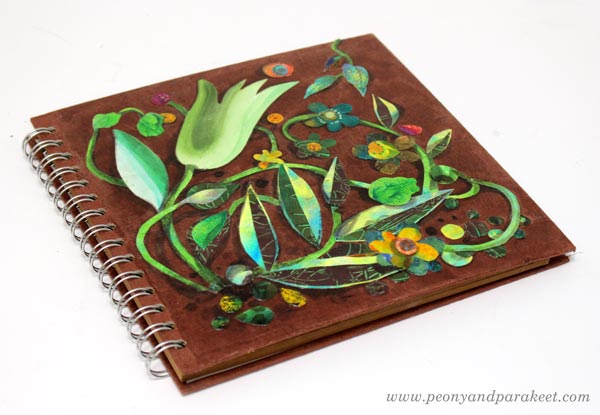
Painted Paper Collage – More Ideas
- For those who want to start by making some papers:
Choose Kiwi, Arboretum or Romantic Doodles - For those who like to play:
Dolls in a Gallery – Paper Collage Step by Step! - For those who need to dig deeper as artists:
Draw Your Innocent Little Secrets! - Class recommendations:
Collageland
Inspirational Drawing
Modern Mid-Century
I hope you found these tips both practical and inspirational!
Doodler’s Sampler Step by Step
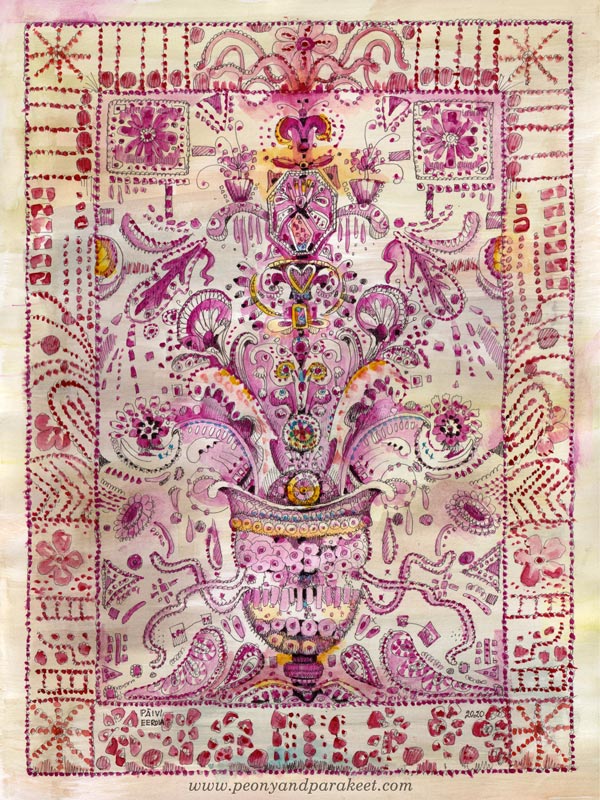
I have always loved antique embroidery, and it inspires my art too. This week, I invite you to treat your pen as a needle and doodle the look of the precious hand-stitched fabric. My drawing – I call this Doodler’s Sampler – is 9 by 12 inches but you can make a smaller or bigger piece with these instructions. The best paper for this is Bristol paper. It’s smooth and nice to color with watercolors.
Step 1 – Draw a Grid
Because we aim for ornamental stiffness, a grid helps to place the elements. Use a pencil so that you can erase the lines before coloring. Start by outlining a space for a frame. Then divide the rest of the paper so that they help to place the main elements.
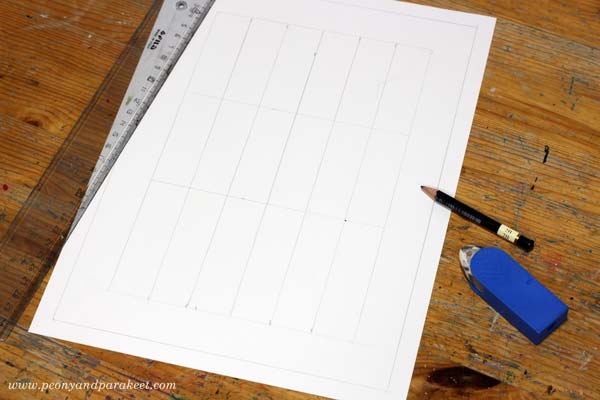
I wanted my Doodler’s Sampler to be symmetrical, so I drew a vertical centerline, and then divided the two halves into three parts. Another idea that I had was to have a vase of flowers. So I drew horizontal lines that mark each third, and the lowest third is reserved for the vase.
Step 2 – Sketch the Structure
Old samplers are filled with decorations but at the beginning, it’s enough to sketch the places for the biggest elements and their shapes.
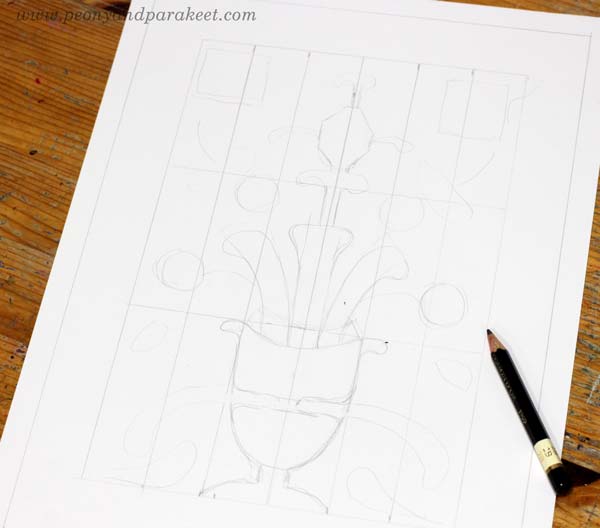
I wanted to have something rectangular on the top corners, the vase on the bottom, plant-like organic shapes coming out of the vase, and then an angular jewel-like thing on the top of the ornament.
Step 3 – Doodle and Decorate
Pick a thin-tipped drawing pen, that has permanent ink, and start doodling! Make more shapes and fill them with circles, rectangles, flowers, hearts, anything you can think of!

My pen is Copic Multiliner, tip size 0.05. I add shadows to my doodles so that they don’t just outline the shapes but there are darker parts too.
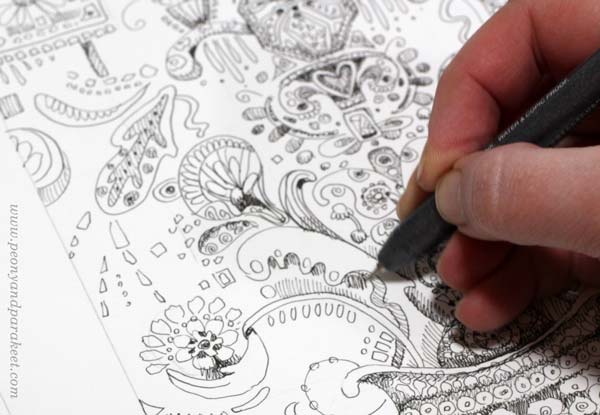
I make the decorative border simpler so that it doesn’t take the power away from the centerpiece. Trembling lines look more decorative than straight ones.
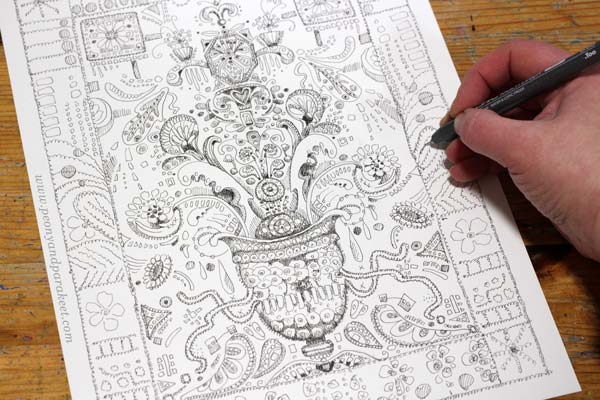
Here’s my Doodler’s Sampler after Step 3, ready for coloring.
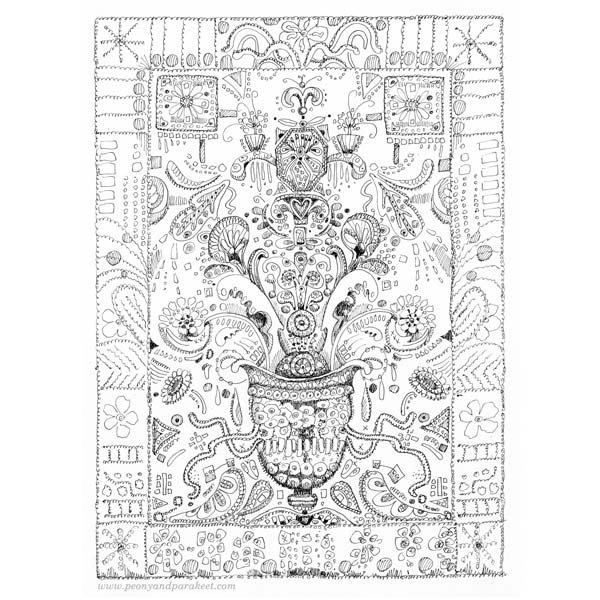
Step 4 – Color the Background
You can use any supplies for coloring, but in my opinion, the softness of watercolors complements the sharp black lines best. Start the coloring by adding some color to the background.

I use very little pigment and many tones so that the background looks like old antique linen.
Step 5 – Color the Doodles
Pick one main color for the sampler. My choice is cool carmine red. When coloring, add more decorations like dots and other decorative shapes. You can also color around a shape instead of inside the shape.
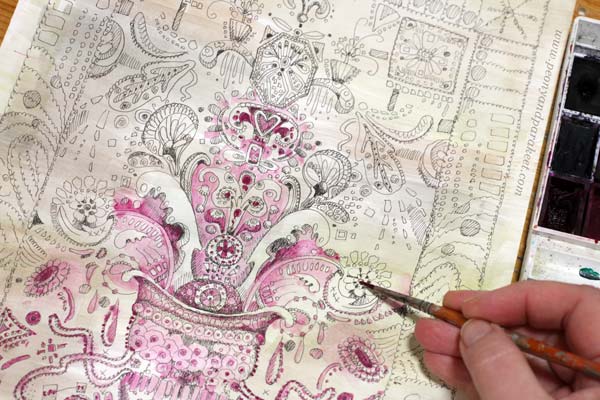
Pick slightly different tones for the frame. I use warmer red and a little bit of orange.
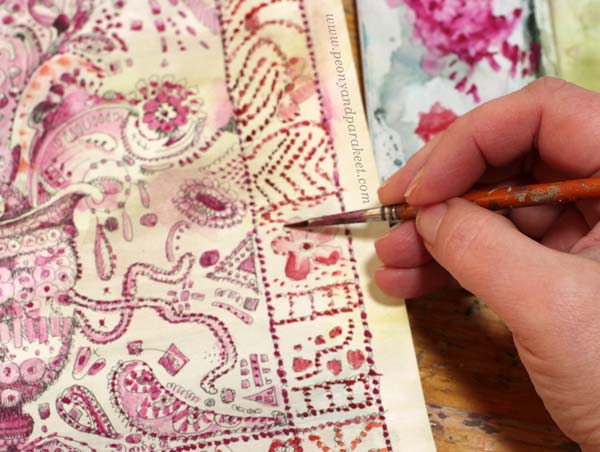
When you have colored the sampler with a very narrow color scheme, make it more lively with some new tones.
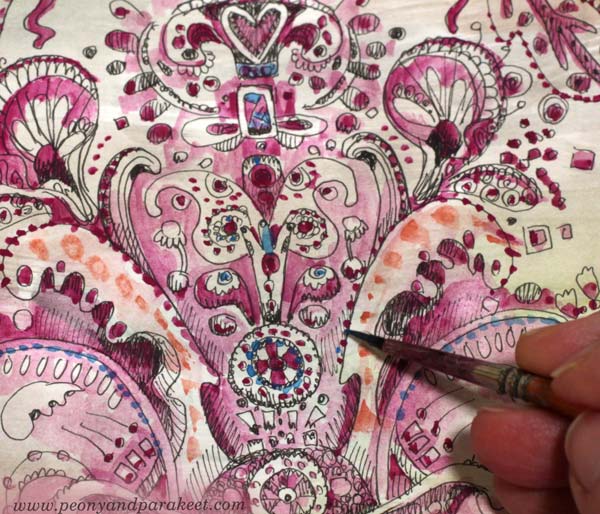
I added blue and yellow, but very sparingly.
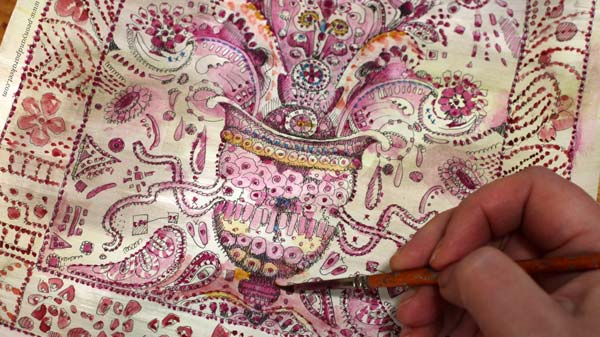
You can also highlight the main elements by making the darkest areas pitch black.
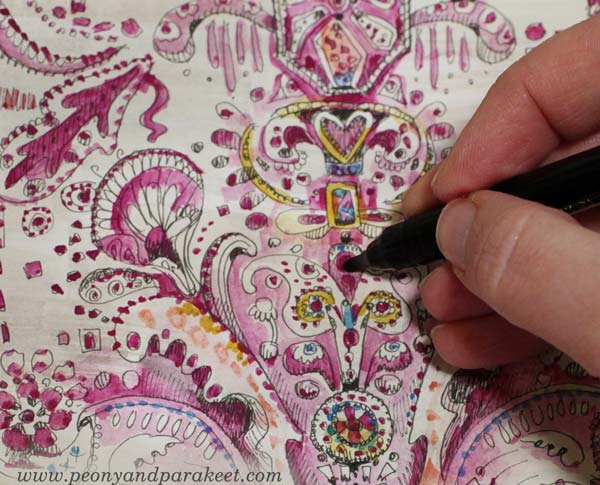
Here are the black and white version and the colored version side by side. Click the image to see it bigger!
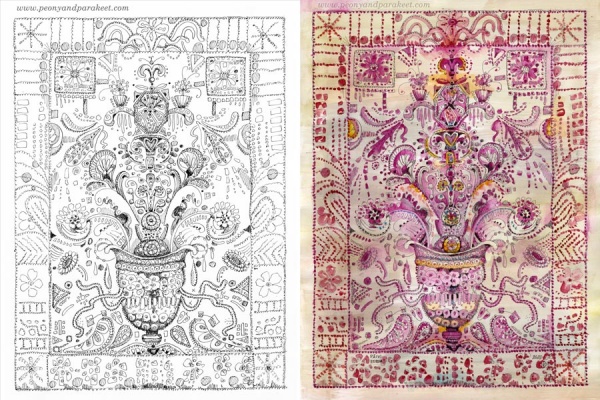
Doodler’s Sampler – For the Love of Flowers and Hand-Stitching
Henri Matisse has said: “I don’t paint things. I only paint the difference between things”. I think that to me, it goes like this: “I don’t paint things. I only paint the similarities between things.” So here’s for the love of flowers and hand-stitching!
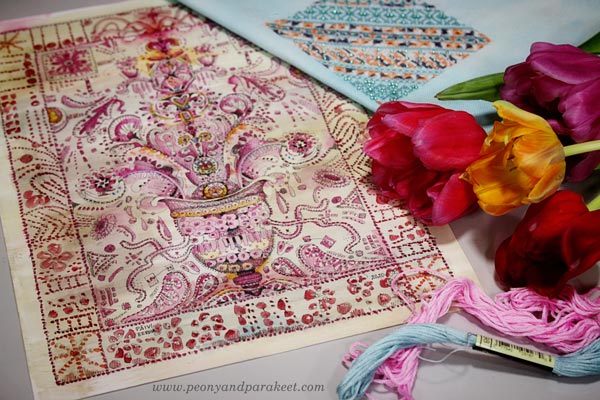
Draw more with me – Check the courses Animal Inkdom and Magical Inkdom!